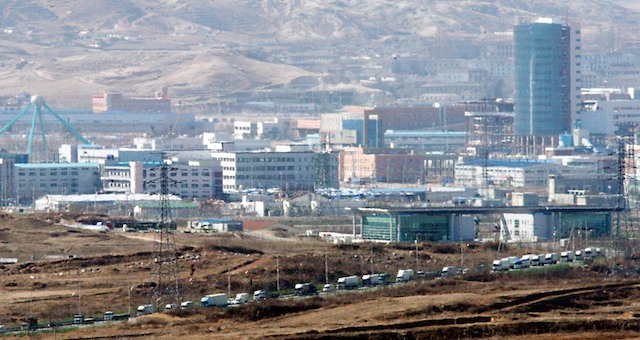SUMMARY
This is AI generated summarization, which may have errors. For context, always refer to the full article.

SEOUL, South Korea – North and South Korea agreed Wednesday to work on reopening a joint industrial zone shut down in April amid soaring military tensions — and vowed to prevent its closure being repeated.
But they failed to set a precise date for the resumption of operations at the shuttered complex in Kaesong, and the South Korean side sounded a note of caution after the deal was announced.
“This agreement is not an end but only a beginning,” its chief negotiator Kim Ki-Woong told reporters.
“What’s more important is how both Koreas can implement the agreement … we can’t say for sure when (Kaesong) will actually reopen,” Kim added.
Nevertheless, the agreement marked a tangible breakthrough after six previous rounds of talks had ended in mutual recrimination.
It may also help ease tensions before the launch of joint South Korea-US military exercises on Monday which the North has warned could bring the divided peninsula “to the brink of war”.
“This is a good sign and it will help the two sides solve other pending issues,” said Kim Yong-Hyun, a North Korean expert at Dongguk University in Seoul.
South Korean President Park Geun-Hye said she hoped the agreement would “set the stage for a fresh start in relations”.
The five-point deal committed both sides to “active efforts” to resume normal operations in Kaesong after inspecting the 123 shuttered South Korean factories housed in the complex.
A joint committee will be set up to oversee the process and discuss compensation for any economic losses suffered.
Compromise reached
Established in 2004 as a rare symbol of inter-Korean cooperation, Kaesong was a major hard-currency earner for the North, bringing it $80 million a year. Pyongyang’s decision to shut it down took many observers by surprise.
The project had managed to ride out previous North-South crises without serious disruption, but it eventually fell victim to an extended period of heightened tension following the North’s third nuclear test in February.
Pyongyang initially barred access to the park, which lies 10 kilometers (six miles) inside the North Korean border, and then withdrew its 53,000-strong workforce from the South’s factories.
The six previous rounds of talks had foundered on the South’s insistence that North Korea provide a binding guarantee that it would not close the complex again.
Wednesday’s agreement suggested a compromise had been reached where the North accepted the worker pullout had closed Kaesong, but both sides jointly promised to ensure it remained open in the future.
“The South and the North will prevent the current suspension of the Kaesong industrial complex caused by the workers’ withdrawal from being repeated again,” it said.
It also included a pledge to promote foreign investment in Kaesong — a key South Korean demand.
The North had proposed the seventh round of talks last week, just hours after Seoul announced it was going to start compensation payments totalling $250 million to the businesses impacted by Kaesong‘s closure.
The payout move was widely seen as the first step towards a permanent withdrawal from the zone.
Wednesday’s accord was immediately welcomed by the South Korean company owners, who had complained that both Seoul and Pyongyang were using their livelihoods as a political football.
“We will do our best to help the Kaesong industrial park boost its international competitiveness and become a globally viable place for investment,” the association said in a statement.
Monday’s annual South Korea-US drill, dubbed “Ulchi Freedom Guardian”, involves about 50,000 South Korean and 30,000 US troops practising a North Korean invasion scenario.
Although largely computer-simulated, it is viewed as highly provocative by North Korea, which has already issued dire warnings of its impact on stability on the peninsula.
“If the drill takes place, conditions in the region will become unpredictable and escalate to the brink of war,” the North’s ruling party newspaper Rodong Sinmun said last month.
The North had cited similar joint exercises earlier this year as the main trigger for Kaesong‘s closure. – Rappler.com
Add a comment
How does this make you feel?
There are no comments yet. Add your comment to start the conversation.